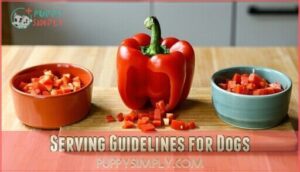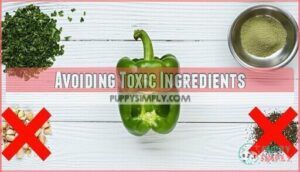This site is supported by our readers. We may earn a commission, at no cost to you, if you purchase through links.

These colorful veggies pack a nutritional punch with vitamin C, vitamin A, and antioxidants that’ll keep your pup’s immune system humming.
Think of red bell peppers as nature’s multivitamin for dogs.
However, there’s a catch you can’t ignore: spicy peppers are off-limits since capsaicin causes digestive chaos.
Always remove seeds and stems, serve small portions, and introduce gradually to avoid tummy troubles.
Your four-legged friend will thank you for this crunchy, healthy treat.
But knowing which peppers to avoid and proper preparation techniques can make all the difference.
Table Of Contents
- Key Takeaways
- Can Dogs Eat Peppers
- Dogs Eating Red Pepper
- Health Benefits Explained
- Preparing Bell Peppers Safely
- Risks of Hot Peppers
- Feeding Bell Peppers Correctly
- Frequently Asked Questions (FAQs)
- Can dogs eat red peppers?
- What to do if your dog eats a bell pepper?
- Can dogs eat sweet peppers?
- Can dogs eat red peppers raw?
- What peppers are toxic to dogs?
- What happens if my dog eats crushed red pepper?
- Are red pepper flakes ok for dogs?
- Is it safe for a dog to eat bell peppers?
- What other fruits and vegetables are safe for dogs to eat?
- Can dogs eat sweet peppers or only red peppers?
- Conclusion
Key Takeaways
- You can safely feed your dog red bell peppers as they’re packed with vitamins A, C, and antioxidants that boost immune health and support vision – just make sure they’re sweet bell peppers, not spicy varieties.
- Always remove seeds and stems before serving, wash thoroughly, and cut into bite-sized pieces to prevent choking hazards and digestive issues in your pup.
- Keep portions small based on your dog’s size – small dogs should get 1-2 pieces, medium dogs a quarter pepper, and large dogs half a pepper maximum, served 2-3 times per week.
- Never give your dog spicy peppers like jalapeños or chili peppers since the capsaicin causes vomiting, diarrhea, and serious digestive upset that’ll make both of you miserable.
Can Dogs Eat Peppers
If you’ve ever caught your dog eyeing your colorful bell pepper while you’re cooking, you’ll be happy to know that most peppers are actually safe for dogs to eat.
However, there’s an important distinction between sweet bell peppers and spicy varieties that every pet owner needs to understand before sharing their snack.
Nutritional Benefits of Bell Peppers
Bell peppers pack serious nutritional value for your furry friend.
**Your pup’s next favorite superfood might already be sitting in your crisper drawer.
These colorful vegetables deliver impressive vitamin content, including vitamins A, C, and E that boost immunity and skin health.
Their antioxidant power fights inflammation while remaining a low calorie treat option.
Plus, bell peppers offer hydration benefits and contribute to a balanced diet without compromising your dog’s health.
They’re also safe for canines, improving overall health.
Safety of Bell Peppers for Dogs
Good news for worried pet parents – all bell peppers are completely safe for dogs.
Pepper color safety isn’t a concern since red, yellow, green, and orange varieties contain zero capsaicin.
Your dog’s digestion of peppers should be smooth when you follow proper pepper preparation tips.
Watch for pepper allergy signs like vomiting, though reactions are rare with these safe vegetables for dogs.
Risks of Feeding Bell Peppers to Dogs
While bell peppers are generally safe, several risks deserve your attention.
Allergies can trigger vomiting and diarrhea in sensitive dogs. Overconsumption risks include gastrointestinal upset from excessive fiber. Create a choking hazard by cutting peppers into bite-sized pieces. Pesticide exposure requires thorough washing before serving.
Watch for digestive issues like upset stomach when introducing peppers gradually.
Bell peppers also offer nutritional benefits for dogs, including vitamins A, C, and E.
Dogs Eating Red Pepper
When your furry friend gives you those puppy-dog eyes while you’re chopping red peppers, you’re probably wondering if it’s safe to share.
The good news? Red pepper for dogs is completely safe and can be a nutritious treat when prepared properly.
Here’s what makes red peppers perfect for your pup:
- Zero capsaicin content – Unlike spicy peppers, red bell peppers won’t cause digestive upset
- High vitamin content – Packed with vitamins A, C, and antioxidants
- Easy pepper digestion – Soft texture when cooked makes them gentle on stomachs
- Natural pepper variety – Sweet flavor appeals to most dogs’ pepper preferences
- Excellent pepper alternatives – Great substitute for processed treats
Most dogs tolerate red peppers well, though pepper allergies are rare.
The benefits of red pepper include immune support and improved coat health.
Always remove seeds and stems before serving, and start with small portions to gauge your dog’s reaction for ideal dog health.
Health Benefits Explained
Red bell peppers pack a nutritional punch that’ll make your dog’s tail wag with more than just excitement.
Your dog’s health deserves the colorful crunch of nutrient-packed red peppers as nature’s perfect treat.
You’re about to discover how these crunchy, colorful vegetables can boost your pup’s immune system, support their eye health, and provide essential vitamins without adding extra calories to their diet, which can also help support their overall well-being.
Vitamins and Antioxidants in Bell Peppers
Red peppers pack an impressive nutritional punch that’ll make your dog’s tail wag with health benefits. These colorful vegetables offer a vitamin variety that puts other treats to shame, delivering powerful antioxidants your pup needs.
| Nutrient | Red Pepper Content | Dog Benefits |
|---|---|---|
| Vitamin C | 9x more than green peppers | Collagen production, healing |
| Beta-Carotene | Highest among bell peppers | Eye health, coat shine |
| Vitamin A | Premium levels | Vision support, skin health |
Red pepper superiority shines through its antioxidant power, offering beta-carotene benefits that support your dog’s overall wellness naturally. To make safe consumption possible, remember to remove seeds and stems first.
Immune System Support
Beyond vitamins, red pepper delivers an Antioxidant Boost that transforms your dog’s immune defenses.
Vitamin C Benefits include enhanced white blood cell function, while powerful antioxidants work on Reducing Inflammation throughout your pup’s body.
This Cellular Protection creates a shield against daily stressors, promoting Overall Wellness that keeps your furry friend bouncing with energy.
- Antioxidants like beta-carotene and lycopene strengthen immune response naturally
- Vitamin C supports stress recovery and boosts disease-fighting capabilities
- Anti-inflammatory compounds help older dogs maintain joint comfort and mobility
Eye Health and Skin Benefits
Your dog’s eyes and coat will thank you for adding red pepper to their diet.
Vitamin A and lutein benefits include sharper vision and reduced eye strain, while beta-carotene supports healthy skin cell renewal.
These antioxidants work together to boost collagen production, giving your pup that glossy coat you’ve always wanted to see, with sharper vision being a notable outcome.
Low-Calorie Snack Option
When you’re looking for healthy treat alternatives, red pepper delivers impressive benefits for weight management.
This dog-friendly vegetable provides excellent hydration while supporting your pup’s balanced diet goals.
Here are five key advantages of this low-calorie option:
- Contains only 30 calories per 100-gram serving
- Offers 92% water content for natural hydration source
- Supports portion control with satisfying fiber
- Provides essential dog nutrition tips for treats
- Delivers vitamins without excess calories
Smart dog diet advice starts with choosing nutritious, low-calorie options like bell peppers, which support weight management.
Preparing Bell Peppers Safely
When you’re ready to share bell peppers with your dog, proper preparation makes all the difference between a healthy treat and a potential stomach upset.
You’ll need to remove seeds and stems, wash thoroughly, and cut the pepper into appropriate bite-sized pieces that match your dog’s size and chewing ability.
Removing Seeds and Stems
Always start by thoroughly cleaning peppers before removing seeds and stems—these parts aren’t toxic but create choking hazards and digestibility issues.
Safe preparation means carefully extracting every seed and trimming stems completely. This simple step prevents indigestion and improves nutrient absorption.
Consider a quality food processor to finely chop vegetables for easier digestion. Your dog’s stomach will thank you for taking time with proper cleaning of these dogsafe vegetables.
Taking time with proper cleaning of these vegetables is essential for your dog’s health.
Cooking and Steaming Methods
Once you’ve removed those pesky seeds and stems, cooking methods can make red pepper easier for your pup to digest.
Steaming offers the best nutrient retention while improving digestibility for sensitive stomachs.
Consider using a dog food steamer for ideal results.
Consider these cooking alternatives:
- Steam for 3-5 minutes to soften without losing vitamins
- Lightly sauté with minimal olive oil
- Roast at low temperatures for enhanced flavor
- Avoid all seasoning – plain cooked peppers only
Serving Guidelines for Dogs
Three key factors determine safe red pepper portions for your furry friend.
Portion control depends on your dog’s size, while preparation methods and serving frequency matter equally for proper dog digestion.
| Dog Size | Serving Amount | Frequency |
|---|---|---|
| Small (under 25 lbs) | 1-2 small pieces | 2-3 times per week |
| Medium (25-60 lbs) | Quarter pepper | 2-3 times per week |
| Large (over 60 lbs) | Half pepper maximum | 2-3 times per week |
The table outlines the specific guidelines for dog size and corresponding serving amounts and frequencies, ensuring proper dog digestion.
Avoiding Toxic Ingredients
When preparing bell peppers, you’re walking a tightrope between healthy treats and toxic foods for dogs.
Even safe peppers become dangerous with the wrong additions. Here’s what transforms nutritious snacks into pepper toxicity dogs face:
- Garlic and Onions – These cause severe onion toxicity and garlic toxicity
- Salt Overload – Creates dehydration and kidney stress
- Seasoning Dangers – Spices irritate digestive systems
- Toxic Combinations – Mixed ingredients multiply risks
Safe Preparation means plain peppers only.
Risks of Hot Peppers
While sweet bell peppers won’t hurt your dog, spicy peppers like jalapeños and chili peppers contain capsaicin that can cause serious digestive problems.
You’ll want to keep these fiery varieties away from your pup since they can trigger vomiting, diarrhea, and stomach pain that’ll leave both of you having a rough day.
Capsaicin and Digestive Issues
Capsaicin in spicy varieties triggers immediate digestive discomfort in dogs.
Unlike mild red pepper, jalapeños and cayenne contain compounds causing pepper-induced vomiting and diarrhea.
Your dog’s capsaicin sensitivity means even small amounts create gastrointestinal issues.
Think of it like eating fire—their stomachs can’t handle the heat.
As a safer alternative, consider that bell peppers are beneficial for canine health.
Capsaicin poisoning symptoms include excessive drooling, stomach pain, and obvious distress requiring immediate attention.
Toxicity of Spicy Peppers
While spicy varieties like jalapeños and chili peppers aren’t technically toxic, they pack enough capsaicin dangers to make your dog miserable.
The pepper severity depends on breed sensitivity—smaller dogs face worse reactions.
Capsaicin irritates their mouth and stomach, causing drooling, vomiting, and diarrhea.
Spicy foods can even trigger long-term effects like stomach ulcers if consumed regularly.
Monitoring for Adverse Reactions
Watch your dog closely after they’ve eaten any pepper.
Allergy symptoms like excessive drooling, vomiting signs, or stool changes need immediate attention.
Appetite changes and behavioral shifts often signal digestive issues brewing.
Monitoring dog reaction helps you catch stomach upset early.
If you notice adverse reactions or allergic reactions developing, contact your vet right away.
Feeding Bell Peppers Correctly
You’ve learned that bell peppers are safe for your dog, but knowing how to serve them properly makes all the difference between a healthy treat and a potential stomach upset.
Getting the portion sizes right and preparing them correctly guarantees your furry friend gets the nutritional benefits without any digestive drama.
Portion Control and Serving Sizes
Getting the Daily Pepper Limit right matters more than you’d think.
Small dog portions should stay under a quarter pepper, while large dog portions can handle half a pepper max.
Size Considerations are key—your Chihuahua’s needs differ from your Golden Retriever’s.
Follow the 10% Treat Percentage rule, keeping bell peppers within treat guidelines for balanced nutrition, and remember that Size Considerations are crucial for your pet’s health.
Introducing Bell Peppers to Dogs
Start your dog’s bell pepper journey with a single small piece during the initial introduction. Like testing waters before diving in, this observational period lets you gauge your pup’s preference while maintaining an allergy watch.
These dog-friendly vegetables deserve a gradual increase approach: Bell peppers boast antioxidant and vitamin benefits, contributing to a dog’s overall health.
- Monitor for digestive changes during the first 24 hours
- Offer bell peppers every few days initially
- Keep portions small until tolerance is established, ensuring a safe and gradual introduction to these nutritious vegetables, rich in antioxidant properties.
Avoiding Overfeeding and Stomach Upset
Now that you’ve introduced red pepper to your dog’s diet, keeping portion sizes reasonable prevents digestive drama.
Even the healthiest treats can backfire when overdone.
Monitor your pup’s stool and watch for signs of indigestion after feeding sessions.
| Dog Size | Safe Portion | Warning Signs |
|---|---|---|
| Small (under 25 lbs) | 1-2 small pieces | Loose stool, vomiting |
| Medium (25-60 lbs) | Quarter pepper max | Excessive gas, lethargy |
| Large (over 60 lbs) | Half pepper limit | Stomach gurgling, refusal to eat |
Gradual introduction helps identify digestive sensitivities before they become serious gastrointestinal health issues.
Moderation keeps your dog’s hydration balance stable while avoiding uncomfortable digestive issues that’ll have both of you regretting treat time.
Supplementing With Bell Peppers
Adding bell peppers to your dog’s diet creates balanced nutrition beyond commercial food.
These dog-friendly vegetables pack vitamins and antioxidants that complement regular meals perfectly.
Try simple recipe ideas like mixing diced red pepper into kibble or creating treat alternatives with steamed pieces.
Consider exploring bell pepper supplements for concentrated nutrients.
Smart dietary integration means bell peppers shouldn’t replace meals but enhance them naturally.
This approach ensures that your dog receives a well-rounded diet with the added benefits of vitamins and antioxidants.
Frequently Asked Questions (FAQs)
Can dogs eat red peppers?
Yes, your dog can safely eat red bell peppers.
They’re packed with vitamins A and C, plus antioxidants.
Just remove seeds and stems, serve in small portions, and avoid any seasoning or spicy varieties.
What to do if your dog eats a bell pepper?
Don’t panic if your furry friend snatches a bell pepper – it’s actually safe.
Monitor them for any stomach upset, but bell peppers are non-toxic and nutritious for dogs when eaten in moderation.
Can dogs eat sweet peppers?
Sweet peppers are perfectly safe for your dog to enjoy.
They’re packed with vitamins A and C, plus antioxidants that boost immunity.
Just remove seeds and stems, then serve in moderation as a healthy treat.
Can dogs eat red peppers raw?
Your dog can safely munch on raw red peppers! They’re packed with vitamins and antioxidants. Just remove the seeds and stem first, then slice into bite-sized pieces to prevent choking.
What peppers are toxic to dogs?
Spicy peppers like jalapeños, chili, and cayenne contain capsaicin that’s toxic to dogs, causing vomiting and diarrhea.
However, bell peppers in all colors are completely safe for your furry friend to enjoy.
What happens if my dog eats crushed red pepper?
About 90% of spice-related dog emergencies involve crushed red pepper.
If your dog ate it, expect drooling, vomiting, and diarrhea within hours.
Offer water immediately and contact your vet—capsaicin causes serious digestive upset requiring professional care.
Are red pepper flakes ok for dogs?
No, red pepper flakes aren’t safe for your dog. They contain capsaicin, which can cause digestive upset, vomiting, and diarrhea. Stick to mild bell peppers instead for a healthy treat.
Is it safe for a dog to eat bell peppers?
Bell peppers contain 92% water, making them incredibly hydrating treats.
Yes, you can safely feed your dog bell peppers.
They’re packed with vitamins A and C, supporting immune health and vision when served properly.
What other fruits and vegetables are safe for dogs to eat?
Safe fruits for dogs include apples (seedless), blueberries, bananas, and watermelon.
Vegetables like carrots, green beans, sweet potatoes, and broccoli work well too.
Always remove seeds, pits, and introduce new foods gradually.
Can dogs eat sweet peppers or only red peppers?
Like traffic lights offering green, yellow, and red options, you can safely feed your dog all sweet pepper colors.
Red, yellow, orange, and green bell peppers are equally safe and nutritious for your furry friend.
Conclusion
Picture your dog’s tail wagging with excitement over their new favorite crunchy snack – that’s the power of safely prepared red bell peppers.
Now you know the answer to "can dogs eat red pepper" is absolutely yes, but only sweet varieties with proper preparation.
Remember to remove seeds, avoid spicy peppers, and start with small portions.
Your furry companion deserves healthy treats that boost their immune system while keeping their digestive system happy and functioning smoothly.

















